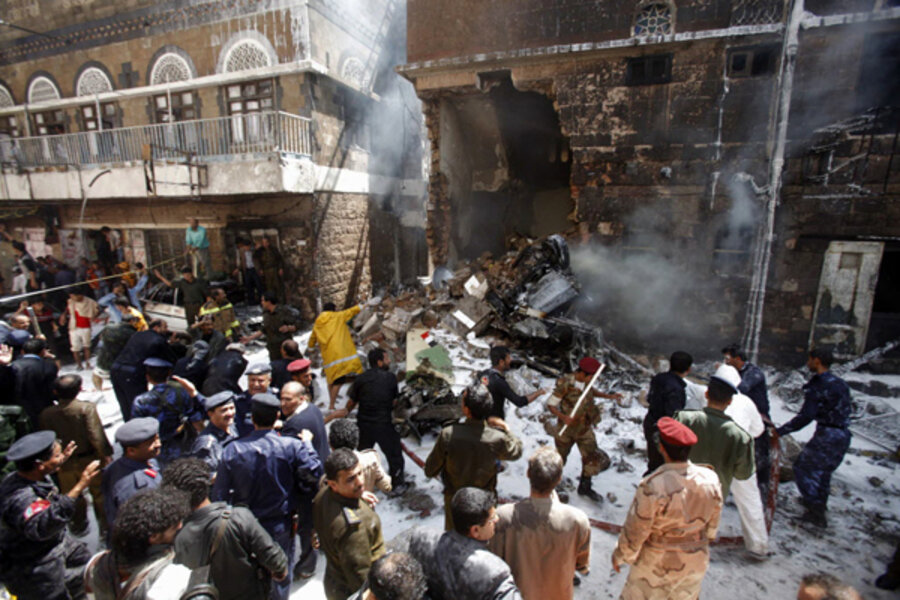Yemeni Air Force suffers embarrassing crashes as Yemenis get angry at US
Loading...
| Sanaa, Yemen
For the second time in less than three months, residents of the Yemeni capital were startled to hear that a military plane had fallen from the sky.
The pilot of the transport plane that crashed in November was able to steer it towards an empty area before it was brought down by a technical problem, killing all 10 aboard. But yesterday’s crash proved more tragic, as a Yemeni fighter jet crashed directly into a residential neighborhood, killing 12, including two children, as it ignited nearby homes.
The heartrending absurdity of yesterday’s incident has tempered the typically ubiquitous conspiracy theories, while activists have reiterated calls – first made in the wake of an apparently accidental explosion at an arms depot in the capital last December – for military installations to be removed from Yemeni cities.
The plane crash has also served as a tragic reminder of the state of Yemen’s dysfunctional, unequipped Air Force. In Yemen itself, the poor state of the Air Force is often embarrassingly cited as a symbol of rampant government corruption, but it is ultimately an issue with international significance.
Yemen is a key focus of US counterterrorism efforts, and in recent years the US has launched a series of air strikes, largely by unmanned drones, against suspected Al Qaeda targets there. The Yemeni government has allowed the strikes, but as their frequency has increased, opposition to the long-controversial policy has grown vocal.
Few Yemenis question the danger that local militants pose, but many argue that the current strategy is flawed. Some accuse the government of violating Yemens' sovereignty by virtually outsourcing the duties of its Air Force to a foreign nation as it fails to bring its own aircraft up to snuff.
Yemen’s current president, Abdo Rabbu Mansour Hadi, has openly backed the US strikes – a break from the quiet consent granted by his predecessor, Ali Abdullah Saleh. Fielding questions at the Wilson Center in Washington, DC last September, Hadi explicitly tied his decision to the state of the country’s Air Force and its inability to battle Al Qaeda-linked militants in the country on its own.
“The Yemeni Air Force cannot carry out missions at night,” he said. “Even if they did, its highly unlikely they will be successful.”
Misgivings about the drone campaign have been heightened by sporadic cases of civilian casualties, most notoriously a strike last fall that missed its target and killed 13 civilians in a bus whose passengers included women and children.
And as the frequency of the strikes have increased, Yemenis have balked, calling it a violation of the nation’s sovereignty, complaining of the opacity of the operations, and saying the strikes have lead to militant blowback and a public outcry that could destabilize the country.
US officials have pushed back against such claims, but many here insist that the strikes have led to an uptick in anti-American sentiment and fueled further distrust of the government in Sanaa.
Locals in the central province of al-Bayda say resentment over American air strikes has prompted many local tribal leaders to refuse to cooperate with the government’s recently launched military offensive against Al Qaeda-linked militants based in the north of the province. And east of Sanaa, a recent attack on an oil pipeline in the restive province of Mareb has been characterized as the result of the failure of negotiations between the government and local tribesmen seeking compensation for damage caused by recent drone strikes.
“The [Yemeni] State’s lack of capacities has left it dependent on the US. But American airstrikes have killed many civilians – including women and children; this is totally against human rights,” says Hooriya Mashoor, Yemen’s Minister of Human Rights. “A good strategy would be [working] to build the capacity of national forces. There are other ways to fight terrorism that have less of a negative impact on civilians.”







